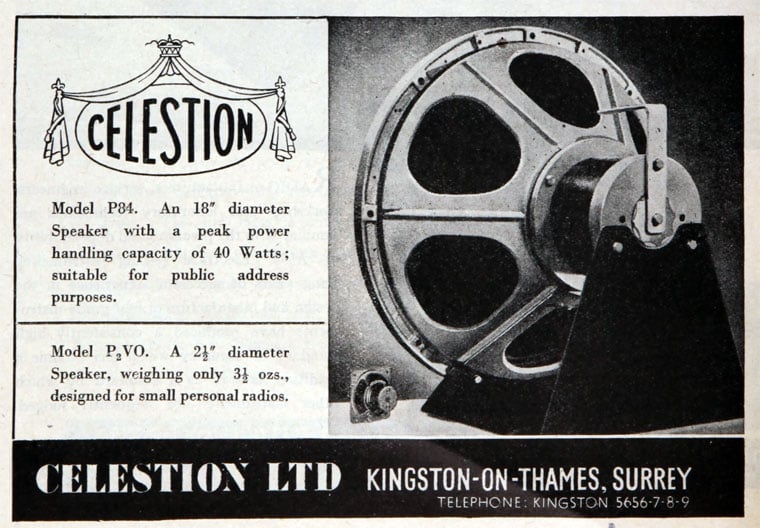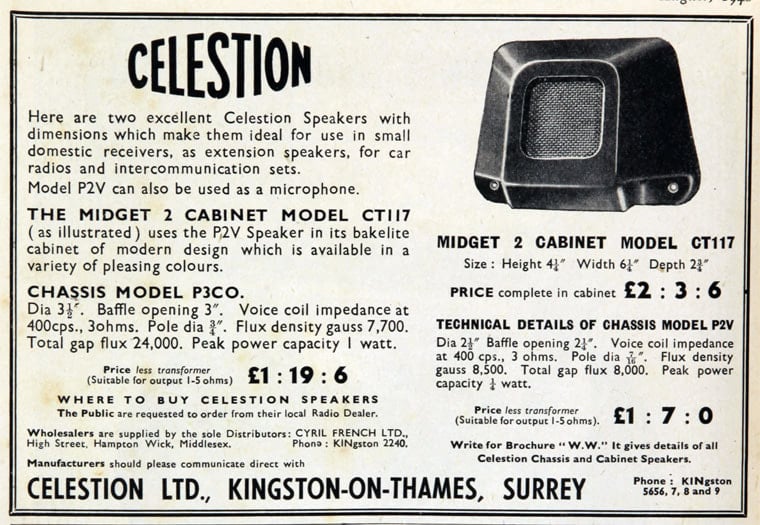If Marshall, Selmer and Vox are among the most important amplifiers in the history of rock and “British sound” this can be partly attributed to their Celestion speakers. In fact, the amplifier, intended as preamp and poweramp, captures the electrical signal sent by the guitar’s pickups and amplifies and elaborates it, but the speakers are responsible for converting it into sound waves that can be listened to, therefore their importance is beyond dispute. A lot of artists and bands have made these speakers an essential part of their sound, from Hendrix to Paul Kossoff, from Angus Young to Slash, from the Beatles to the Rolling Stones.
It all began in 1924, when Eric Vincent Macintosh turned to Cyril French to develop and produce his invention: a “free-vibrating edge" speaker. Cyril, together with his brothers Leonard and Edgar, founded the Electrical Manufacturing and Plating Company, in a small building at 29 High Street in Hampton Wick, in the outskirts of London.
It all began in 1924, when Eric Vincent Macintosh turned to Cyril French to develop and produce his invention: a “free-vibrating edge" speaker. Cyril, together with his brothers Leonard and Edgar, founded the Electrical Manufacturing and Plating Company, in a small building at 29 High Street in Hampton Wick, in the outskirts of London.
In 1925 Cyril and Eric filed the patent for the “clamped-edge” speaker and perfected Eric’s “free-vibrating edge” project, giving birth to a new speaker called Celestion by Ralph French, another of Cyril’s brothers. Launched as “The speaker of distinction,” the Celestion represented an authentic revolution in the field of speakers and had a fine “free-vibrating edge” cone reinforced with small radial and spiral bamboo rods.
In 1926 the company changed its name to Celestion Radio Company which was taken over by the limited liability company Celestion Limited from 1928.
The motto, “The very Soul of Music,” dates back to this period and was used for a very long time
The motto, “The very Soul of Music,” dates back to this period and was used for a very long time
Business was booming as was the radio and in 1929 the factory was moved to a bigger building at 145 London Road, Kingston Upon Thames, in the county of Surrey, not very far from Hampton Wick.
The success of the company grew further when in 1932 it presented its first permanent-magnet moving-coil speaker (PPM) and the Retone Dual, the first dual speaker system ever built, with its mind blowing (for those times) 2 watt speaker!
The success of the company grew further when in 1932 it presented its first permanent-magnet moving-coil speaker (PPM) and the Retone Dual, the first dual speaker system ever built, with its mind blowing (for those times) 2 watt speaker!
However, the depression of the '30s hit Celestion hard too. Both Cyril and Eric left the company and Cyril returned to the old factory in Hampton Wick to take care of the distribution of the Celestions in the United Kingdom.
During the Second World War the Celestion began producing speakers and band repeaters for ships and anti-air-raid sirens.
In 1947 the London British Rola, English branch of the American Rola Company of Cleveland, Ohio, which also produced speakers, bought Celestion.
In 1936 the Rola factory in Minerva Road, London, had developed the first speaker that still responded to modern standards, the G12, used for radio and also used in the 1957 Vox AC15. After the merger, the name of the company changed to Rola Celestion and in 1948 its production was moved to the “Ferry Works” factory in Thames Ditton, also in Surrey.
During the Second World War the Celestion began producing speakers and band repeaters for ships and anti-air-raid sirens.
In 1947 the London British Rola, English branch of the American Rola Company of Cleveland, Ohio, which also produced speakers, bought Celestion.
In 1936 the Rola factory in Minerva Road, London, had developed the first speaker that still responded to modern standards, the G12, used for radio and also used in the 1957 Vox AC15. After the merger, the name of the company changed to Rola Celestion and in 1948 its production was moved to the “Ferry Works” factory in Thames Ditton, also in Surrey.
After the war the company continued producing speakers for radio, television and hi-fi systems, and in 1949 it was bought by Truvox, a company based in Wimbledon, also specialising in sound diffusion systems. The new Celestion covered the national demands for speakers, that included radio, television, cinema and the most diverse acoustic instruments for the British military.
Over the years, Celestion used a lot of acronyms to identify its speakers, such as “P”, “C”, “CT”, ( “Celestion Type”), “RT” (“Rola Type”), “PPM”, (“Permanent magnet moving-coil”), and, in 1954, after the acquisition by Truvox, with “T” for “Truvox”.
The increased demand for Celestion speakers made it necessary to expand the factory, but the river and roads in Thames Ditton prevented it, so in 1968 work began on a bigger factory in Foxhall Road in Ipswich, capital of the English county of Suffolk. “Ditton Works”, the new factory named after the Thames Ditton staff who trained the workers, became operative in December 1968.
In 1970, the production of G12 was transferred to Ipswich, while the production of the hi-fi systems remained in Thames ditton until the factory closed in 1975, when a new factory for the assembly of hi-fi speakers was opened in Hadleigh Road Trading estate, Ipswich, and remained operative until the beginning of the '80s.
Over the years, Celestion used a lot of acronyms to identify its speakers, such as “P”, “C”, “CT”, ( “Celestion Type”), “RT” (“Rola Type”), “PPM”, (“Permanent magnet moving-coil”), and, in 1954, after the acquisition by Truvox, with “T” for “Truvox”.
The increased demand for Celestion speakers made it necessary to expand the factory, but the river and roads in Thames Ditton prevented it, so in 1968 work began on a bigger factory in Foxhall Road in Ipswich, capital of the English county of Suffolk. “Ditton Works”, the new factory named after the Thames Ditton staff who trained the workers, became operative in December 1968.
In 1970, the production of G12 was transferred to Ipswich, while the production of the hi-fi systems remained in Thames ditton until the factory closed in 1975, when a new factory for the assembly of hi-fi speakers was opened in Hadleigh Road Trading estate, Ipswich, and remained operative until the beginning of the '80s.
In the '70s the company changed its name twice to: Celestion Industries in 1970 and Celestion International in 1979.
In 1992 it was bought by Kinergetics Holdings UK Limited, whose major shareholder was Gold Peak from Hong Kong, and who also bought another British company that produced speakers, KEF. As a logical consequence of this change in management, today most of Celestion’s products come from China. However, its main headquarters is still in England to highlight that Celestion is still a British brand.
In 1992 it was bought by Kinergetics Holdings UK Limited, whose major shareholder was Gold Peak from Hong Kong, and who also bought another British company that produced speakers, KEF. As a logical consequence of this change in management, today most of Celestion’s products come from China. However, its main headquarters is still in England to highlight that Celestion is still a British brand.
Antonio Calvosa


















